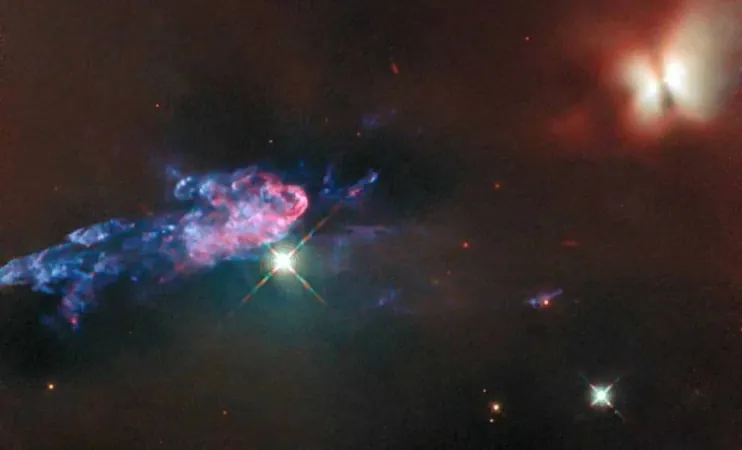
Hubble Captures Stunning Newborn Stars in the Orion Nebula – A Cosmic Birth Revealed!
2025-01-14
Author: Ting
The Orion Nebula: A Cosmic Nursery
The Orion Nebula, known as the closest massive star-forming region to Earth, has always mesmerized astronomers and stargazers with its vibrant glow and bustling activity. Recently, the Hubble Space Telescope has released sensational new images that provide a revealing glimpse into this cosmic nursery, showcasing the captivating processes that govern the birth of stars. Located about 1,300 light-years away, just beneath the three stars of Orion's Belt, this nebula serves as a significant hub for star formation, where young protostars emerge from dense clouds of gas and dust.
Meet the Stars: HOPS 150 and HOPS 153
One of the standout elements in Hubble’s latest imagery includes the binary system known as HOPS 150. This pair of young protostars, discovered through the Herschel Orion Protostar Survey, is cocooned by thick disks of gas and dust, which act as their raw materials for growth. Currently in a transitional phase toward stellar maturity, these protostars are actively drawing in material from their environments.
A dramatic feature of the Hubble image is a colossal dark cloud of gas and dust, spanning over 2,000 times the distance between the Earth and the Sun. While this immense structure obscures parts of the glowing nebula, it simultaneously illustrates the intense forces at play. As material accelerates toward the protostars, it heats up and emits light across a spectrum of wavelengths, allowing scientists to gauge the developmental stages of these celestial bodies. HOPS 150 exemplifies the intricate and interconnected nature of star formation, where every component plays a critical role in shaping newborn stars.
Introducing the younger and less-developed HOPS 153, this protostar remains enveloped in cold, dense gas. Although Hubble cannot visibly detect HOPS 153 itself due to its shrouded nature, its presence is unveiled through brilliant jets of material emitted into space. These dynamic jets cut through the surrounding interstellar medium, glowing as they collide with nearby gas and dust, highlighting the tumultuous environment of star formation.
The Orion Nebula: A Cosmic Laboratory
For centuries, the Orion Nebula has been at the forefront of astronomical research into star formation, easily visible to the naked eye during clear nights. Its proximity to Earth makes it a natural laboratory for astronomers, allowing high-resolution observations of its stunning structures, which include dense clouds and brilliant jets of gas. Hubble's latest image showcases a breathtaking interplay of light and shadow, where dense clouds create dark silhouettes during nighttime, while radiant outflows carve bright trails through the nebula.
Understanding this delicate balance of forces deep within the Orion Nebula is pivotal. Gravity actively pulls material inward to nurture emerging stars, while radiation and energetic jets push outward, delicately shaping the environment for new celestial objects.
The Significance of Star Formation Research
Deciphering the complex processes occurring in regions like the Orion Nebula holds critical importance for unraveling some of the universe's most pressing questions. How do stars form from their progenitor materials? What roles do jets and outflows play in a star's growth? And how do these stellar birth processes affect the formation of planets and other celestial bodies?
The findings from Hubble’s observations of HOPS 150 and HOPS 153 enrich our overall understanding of star formation not just in our galaxy, but across the universe. By examining these stars and their cosmic cradle, astronomers can further refine their models of stellar evolution and perhaps glean insights into the birth of our own Sun and solar system millions of years ago.
Looking Ahead: The Future of Star Formation Exploration
While Hubble’s contributions to our knowledge of the Orion Nebula are invaluable, future telescopes such as the James Webb Space Telescope (JWST) promise to elevate our understanding to new heights. With its advanced infrared capabilities, JWST is set to penetrate the dense clouds of gas and unveil even younger and more concealed protostars, enriching the tapestry of knowledge about star formation.
As we embark on this exciting journey of discovery through the Orion Nebula, one thing is clear: our fascination with the universe inspires new generations of dreamers and scientists to gaze up at the cosmos, ready to unravel its myriad secrets. Stay tuned for more astonishing revelations from the depths of space!




 Brasil (PT)
Brasil (PT)
 Canada (EN)
Canada (EN)
 Chile (ES)
Chile (ES)
 Česko (CS)
Česko (CS)
 대한민국 (KO)
대한민국 (KO)
 España (ES)
España (ES)
 France (FR)
France (FR)
 Hong Kong (EN)
Hong Kong (EN)
 Italia (IT)
Italia (IT)
 日本 (JA)
日本 (JA)
 Magyarország (HU)
Magyarország (HU)
 Norge (NO)
Norge (NO)
 Polska (PL)
Polska (PL)
 Schweiz (DE)
Schweiz (DE)
 Singapore (EN)
Singapore (EN)
 Sverige (SV)
Sverige (SV)
 Suomi (FI)
Suomi (FI)
 Türkiye (TR)
Türkiye (TR)
 الإمارات العربية المتحدة (AR)
الإمارات العربية المتحدة (AR)